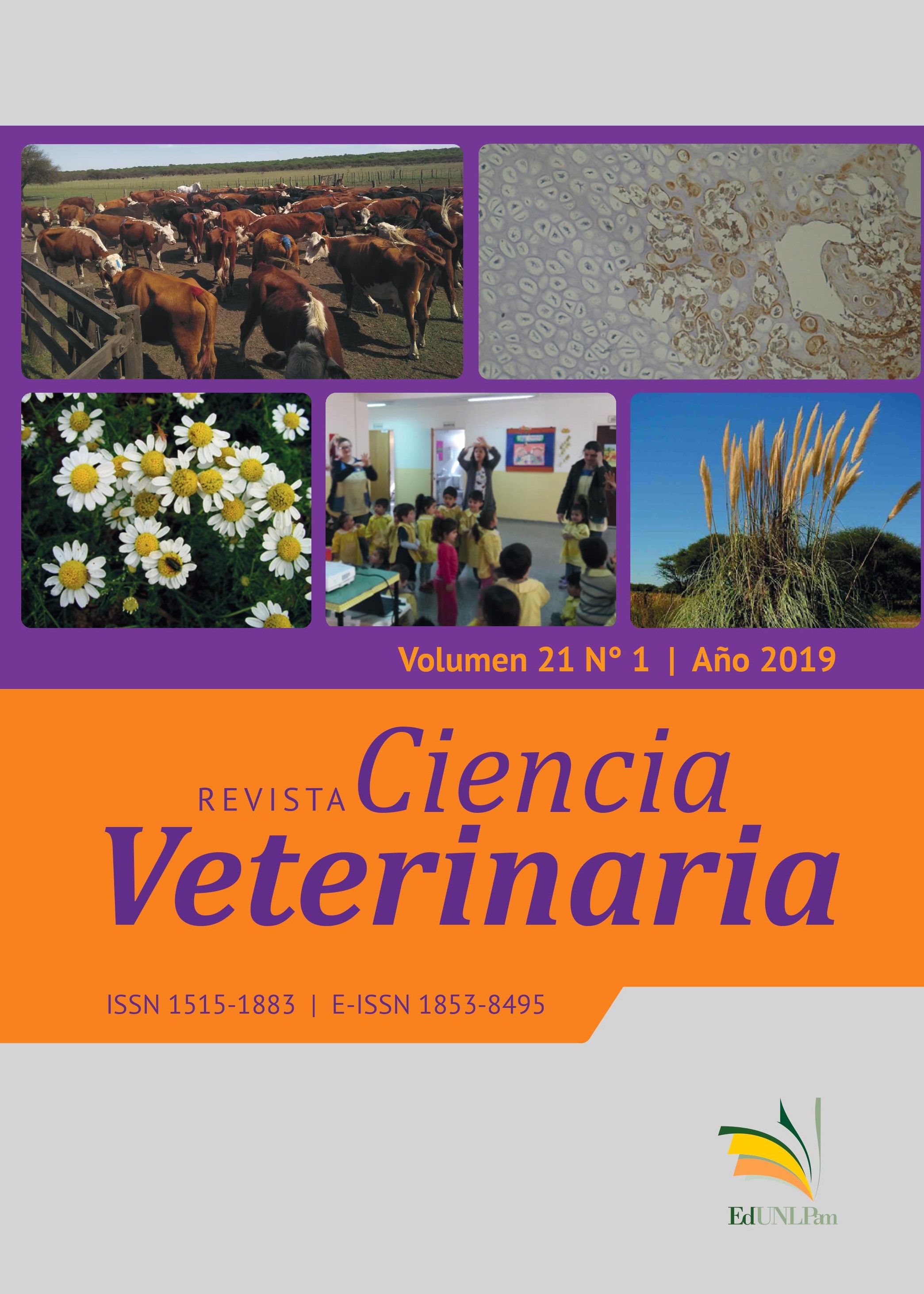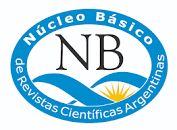Temporal and spatial immunolocalization of osteopontin in the repair of orthopaedic bone defects treated with demineralized bone matrix / Inmunolocalización temporal y espacial de osteopontina en la reparación de defectos óseos ortopédicos tratados con
DOI:
https://doi.org/10.19137/cienvet-201921104Keywords:
Rabbit, bone, osteopontin, inmunomarcation, demineralized bone matrixAbstract
Osteopontin (OPN) is the most abundant non-collagen protein in the bone matrix, where it fulfils the function of cellular adhesion and biomineralization. In the present work, the authors report the temporal and spatial localization of OPN during the repair of experimental orthopaedic bone defects treated with demineralized bone matrix (DBM) processed by the authors. 30 rabbits were used, which were given an orthopaedic bone defect of critical size in one of the radiuses, which was filled with DBM. The rabbits were euthanized in groups of 5 individuals at days 7, 15, 21, 30, 60 and 150. Histological cuts were immunomarked to establish the spatial and temporal immunomarcation of OPN. The histological cuts were observed with an optic microscope with which histological images were captured and analysed with the ImageJ software. The image analysis allowed the authors to establish the optic density (OD) and the integrated optic density (IOD). The data was analysed with the ANOVA and Fischer LSD tests. At day 7, the presence of OPN was observed only in the DBM particles, where the OD was 0.08 and the IOD was 1.64; at day 15, OPN marked different sites of collagen condensations and cells contained in the interior of the matrix. In this period the OD was 0.096 and the IOD, 9.26. At days 21 and 30, the OPN immunosignalled osteocytes, osteoblasts, osteoclasts and hypertrophic chondrocytes in the bone trabeculae adjacent to the ossification zones. At day 21 the OD was 0.17 and IOD 6.22. At day 30, the OD was 0.14 and the IOD 2.52. At days 60 and 150, OPN was evenly distributed in the new bone matrix with an OD: 0.10 and IOD: 0.48, and OD: 0.35 and IOD: 3.80, respectively. The OD and IOD showed significant differences (p<=0.05) between days 7, 15, 21 and 30; and there was no difference at days 60 and 150 (p=0.05). OPN was found in the DBM particles: it increased the optic densities at day 15 and it diminished at day 60, after which it increased the OD and IOD again until day 150. It was established that the OPN immunoexpressed during the repair process in indifferentiated cells, osteoprogenitor chondrocytes and osteoblasts. The variation of OD and IOD allowed the authors to establish that the greatest degree of immunoexpression of OPN was at day 15 after repair initiated. On the other hand, the increase registered between days 60 and 150 post treatment was due to the biomineralization of the bone matrix.
Downloads
References
Urist, M. R. Bone formation by autoinduction. Science.1965; 150:893-899.
Colnot, C., D. M. Romero, S. Huang & J. A. Helms.Mechanism of action of demineralized bone matrix in the repair of cortical bone defects. Clinical Orthopaedic Related Research. 2005; 435:69-78.
Eppley, B. L., W. S. Pietrzak & M. W. Blanton. Allograft and alloplastic bone substitutes: a review of science and technology for the craniomaxillofacial surgeon. Journal of Craniofacial Surgery. 2005; 16:981-989.
McKee, M. D., C. M. Farach, W. T. Butler, P. V. Hauschka & A. Nanci. Ultrastructural
immunolocalization of noncollagenous (osteopontin and osteocalcin) and plasma
(albumin and alpha 2HSglycoprotein) proteins in rat bone. Journal of Bone Mineral Research. 1993; 8:485–496.
Weber, G. F., S. Ashkar, Glimcher, M. J. & H. Cantor. Receptor-ligand interaction between CD44 and osteopontin (Eta-1). Science. 1996; 271:509-512.
Chellaniah, M. A, K. A. Hruska. The integrin alpha(v)beta(3) and CD44 regulate the actions of osteopontin on osteoclast motility. Calcified Tissue International. 2003; 72:197–205.
Zhu, B., K. Suzuki, H. A. Goldberg, S. R. Rittling, D. T. Denhardt, C. A. McCulloch & J. Sodek. Osteopontin modulates CD44-dependent chemotaxis of peritoneal macrophages through G-protein-coupled receptors: evidence of a role for an intracellular form of osteopontin. Journal of Cell Physiology. 2004; 198: 155–167.
Uemura, T., A. Nemoto, Y. K. Liu, H. Kojima, J. Dong, T. Yabe, T. Yoshikawa, H. A. Ohgushi, T. Ushida & T. Tateishia. Osteopontin involvement in bone remodeling and its effects on in vivo osteogenic potential of bone marrow-derived osteoblasts/porous hydroxyapatite constructs. Materials Science and Engineering. 2001; 17:33–36
Sodek, J., B. Ganss & M. D. McKee. Osteopontin. Critical Review in Oral Biology and Medicine. 2000; 11: 279–303.
Lesley, J., R. Hyman, P.W. Kincade. Hyaluronan binding by cell surface CD44. Journal of Biological Chemistry. 2000; 275:26967-26975.
Hollinger, J. O. & J. C. Kleinschmidt. The critical size defect as an experimental model to test bone repair methods. Journal of Craniofacial Surgery. 1990; 1:60-68
Audisio, S. A., P. G. Vaquero, P. A. Torres, E. C., L. N. Ocampo, V. Ratusnu, A. L., Cristofolini, C. I. Merkis. Obtención, caracterización y almacenamiento de matriz ósea desmineralizada. Revista de Medicina Veterinaria. 2014; 95:27-34.
Vasconcellos, A., C. Cisternas & M. Paredes. Estudio inmunohistoquímico comparativo del receptor de estrógeno en tejido endometrial de ovejas razas Texel y Araucana. International Journal of Morphology. 2014; 32:1120-1124
Di Rienzo, J.A., F. Casanoves, M.G. Balzarini, L. Gonzalez, M Tablada & C.W. Robledo. InfoStat versión Grupo InfoStat, FCA, Universidad Nacional de Córdoba, Argentina. 2010.
Yasui, N., M. Sato, T. Ochi, T. Kimura, H. Kawahata, Y. Kitamura & S. Nomura. Three modes of ossification during distraction osteogenesis in the rat. Journal of Bone and Joint Surgery.1997; 79,:824-830
Radomisli, T. E., D. C. Moore, H. J. Barrach, H. S. Keeping & M. G. Ehrlich.. Weight-bearing alters the expression of collagen types I and II, BMP 2/4 and osteocalcin in the early stages of distraction osteogenesis. Journal of Orthopedic Research. 2001; 19:1049-1056
Jang, J. H. & Kim J.H. Improved cellular response of osteoblast cells using recombinant human osteopontin protein produced by Escherichia coli. Biotechnology Letter. 2005; 27:1767–1770.
Lian, J. B., M. D. McKee MD, Todd AM, Gerstenfeld LC. Induction of bone-related proteins, osteocalcin and osteopontin, and their matrix ultrastructural localization with development of chondrocyte hypertrophy in vitro. Journal of Cellular Biochemistry. 1993; 52:206–219
Silbermann, M., D. Lewinson, H. Gonen, M. A. Lizarbe & K. von der Mark K. In vitro transformation of chondroprogenitor cells into osteoblasts and the formation of new membrane bone. The Anatomy Record. 1983; 206: 373-383.
Moskalewski, S. & J. Malejejcyk.. Bone formation following intrarenal transplantation of isolated murine chondrocytes: chondrocyte – bone cell differentiation. Development. 1989; 107: 473-480
Thesingh, C. W., Groot, C. G. & A. M. Wassenaar.Transdifferentiation of hypertrophic chondrocytes into osteoblasts in murine fetal metatarsal bones, induced by co-cultured cerebrum. Bone and Mineral Research.1991; 12:5-40.
Descalzi Cancedda, F., C. Gentili, P. Manduca & R. Cancedda. Hypertrophic chondrocytes undergo further differentiation in culture. Journal of Cellular Biology. 1992; 117:427-435
Enishi, T., K. Yukata, M. Takahashi, R. Sato, K. Sairyo K, N. Yasui. Hypertrophic chondrocytes in the rabbit growth plate can proliferate and differentiate into osteogenic cells when capillary invasion is interposed by a membrane filter. 2014; PLoS ONE 9, e104638
Yang, G., L. Zhu, N. Hou, Y. Lan, X. M. XM, B. Zhou, Y. Teng & X. Yang. Osteogenic fate of hypertrophic chondrocytes. Cell Research. 2014a;24:1266-1269.
Yang, L., K. Y. Tsang, H. C. Tang, D. Chan & K. S. Cheah.. Hypertrophic chondrocytes can become osteoblasts and osteocytes in endochondral bone formation. Proceedings of National Academy Science. 2014b; 111:12097-12102.
Zhou, X., K. von der Mark, S. Henry, W. Norton, H. Adams, B. de Crombrugghe..
Chondrocytes transdifferentiate into osteoblasts in endochondral bone during development, postnatal growth and fracture healing in mice. PLoS Genetics. 2014; 10, e1004820
Jung, P., M. Gebhardt, S. Golovchenko, F. Perez-Branguli, T. Hattori, C. Hartmann, X. Zhou, B. deCrombrugghe, M. Stock, H. Schneider & K. von der Mark. Dual pathways to endochondral osteoblasts: a novel chondrocytederived osteoprogenitor cell identified in hypertrophic cartilage. Biology Open. 2015; 4,608–621.
Kawakami, T. Immunohistochemistry of BMP induced heterotopic osteogenesis. Journal of Hard Tissue Biology.2001; 10:73-76.
Downloads
Published
How to Cite
Issue
Section
License
Al momento de enviar sus contribuciones, los colaboradores deberán declarar , de manera fehaciente, que poseen el permiso del archivo o repositorio donde se obtuvieron los documentos que se anexan al trabajo, cualquiera sea su formato (manuscritos inéditos, imágenes, archivos audiovisuales, etc.), permiso que los autoriza a publicarlos y reproducirlos, liberando a la revista y sus editores de toda responsabilidad o reclamo de terceros , los autores deben adherir a la licencia Creative Commons denominada “Atribución - No Comercial CC BY-NC-SA”, mediante la cual el autor permite copiar, reproducir, distribuir, comunicar públicamente la obra y generar obras derivadas, siempre y cuando se cite y reconozca al autor original. No se permite, sin embargo, utilizar la obra con fines comerciales.









.jpg)

4.png)


7.png)



